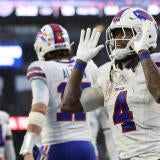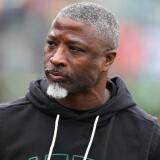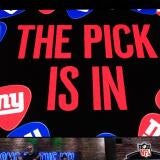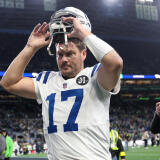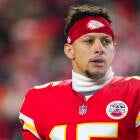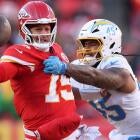2020 NFL Draft: Justin Herbert may be special, but Oregon's history of NFL quarterback busts is concerning
A look at the daunting track record of former Ducks who were drafted to play under center
As the 2020 NFL Draft draws near, the Justin Herbert hype train continues to gain steam. Among the consensus top quarterback prospects of this year's class, the 22-year-old is now being speculated as a candidate to go ahead of Alabama star Tua Tagovailoa when the draft kicks off April 23, with some even predicting a Miami Dolphins trade up to take Herbert No. 2 overall. Opinions on the 6-foot-6 signal-caller are varied. Some see one of the sharpest minds at the position. Others see a passer who crumbles under pressure. No matter what you think of Herbert as a 2020 prospect, however, one thing is for certain: He'll be attempting to break the mold when it comes to QBs coming out of Oregon.
Some schools are hailed as QB factories -- USC, Miami, Stanford and Washington among them. Oregon, on the other hand, has a largely atrocious track record of churning out NFL talent at the position. A better description, in fact, might be that it's a true boom-or-bust indicator of pro production because while Ducks alumni include a pair of Hall of Famers in Dan Fouts and Norm Van Brocklin, the latter of whom won two NFL titles, just about every "big" Oregon QB to be drafted since Fouts, in 1973, has not panned out.
Here's a look at every single Oregon QB to be drafted to the NFL:
| Year drafted | Round (pick) drafted | QB | NFL team |
|---|---|---|---|
2018 | 1 (2) | ||
2008 | 5 (156) | ||
| 2006 | 2 (49) | Kellen Clemens | Jets |
| 2002 | 1 (3) | Joey Harrington | Lions |
| 2001 | 5 (155) | A.J. Feeley | Eagles |
| 1999 | 1 (3) | Akili Smith | Bengals |
| 1997 | 7 (204) | Tony Graziani | Falcons |
| 1991 | 4 (106) | Bill Musgrave | Cowboys |
| 1987 | 1 (13) | Chris Miller | Falcons |
| 1973 | 3 (64) | Dan Fouts | Chargers |
| 1966 | 17 (248) | Mike Brundage | Steelers |
| 1964 | 11 (142) | Bob Berry | Eagles |
| 1960 | 12 (139) | Dave Grosz | Eagles |
| 1955 | 1 (1) | George Shaw | Colts |
| 1949 | 4 (37) | Norm Van Brocklin | Rams |
Again, the list isn't barren. Fouts is one of the greatest Chargers of all time, Van Brocklin won a championship with two different teams, and Berry had a surprise Pro Bowl run amid a spot-starter career despite never playing for the team that drafted him.
But all three of those guys haven't played football for more than 30 years. Take the entire crop of QBs into account, with a specific focus on recent high draft picks at the position, and things get especially ugly:
| QB | Teams | Notes |
|---|---|---|
Norm Van Brocklin | Rams, Eagles | 9-time Pro Bowler, Hall of Famer, two-time NFL champion |
Dan Fouts | Chargers | 6-time Pro Bowler, Hall of Famer |
| Chris Miller | Falcons, Rams, Broncos | 1-time Pro Bowler |
| Bob Berry | Vikings, Falcons | 1-time Pro Bowler |
Marcus Mariota | Titans, Raiders | Average starter |
A.J. Feeley | Eagles, Dolphins, Chargers, Panthers, Rams | Career backup |
| Kellen Clemens | Jets, Rams, Chargers | Career backup |
| Dennis Dixon | Steelers | Career backup |
| Tony Graziani | Falcons, Browns | Career backup |
| Bill Musgrave | 49ers, Broncos | Career backup |
Joey Harrington | Lions, Dolphins, Falcons, Saints | First-round bust |
| George Shaw | Colts, Giants, Vikings, Broncos | First-round bust |
Akili Smith | Bengals | First-round bust |
| Dave Grosz | Eagles | Never played |
Mike Brundage | Steelers | Never played |
It's not just that most of the Oregon QBs that went pro didn't do much in the NFL; that can be said for just about every school, at every position. It's the scary reality that, with such a small sample size of QBs, Oregon has still produced four major first-round busts (with Miller on the brink as a fifth, considering he still went 13th overall).
Here's a look at what every single first-round Oregon QB did or has done in the NFL:
Marcus Mariota went 29-32 as a starter with the Titans, lasting five years but never playing a full season, before settling for a backup job with the Las Vegas Raiders entering 2020. In his contract year, Mariota lost his starting job to Ryan Tannehill and watched the latter lead Tennessee to the playoffs, finishing his Titans tenure with 76 touchdowns, 44 interceptions and an 89.3 passer rating.
Joey Harrington went 18-37 as a starter with the Lions, lasting four years with Detroit before being traded for a future fifth-round pick. Between being benched for Jeff Garcia and Jon Kitna, he threw 60 TDs, 62 INTs and logged a 68.1 passer rating, then backed up a rehabilitating Daunte Culpepper with the Miami Dolphins. He finished his career as a reserve with the Falcons and Saints.
Akili Smith missed most of his rookie training camp amid a contract dispute with the Bengals, then started just 17 games in four years with the team, going 3-14 while throwing five TDs and 13 INTs for a 52.8 rating. After spending a year out of football, Smith resurfaced in the NFL Europe and Canadian Football League.
Chris Miller lasted seven seasons with the Falcons and produced solid numbers in 1991-1992, helping lead the team to the playoffs with a 26-TD Pro Bowl performance and starting '92 even better. But injuries, including a torn ACL and multiple concussions, limited his long-term impact, and he still went just 23-43 in starts with Atlanta. He finished his career with the Rams and Broncos.
George Shaw was OK as a rookie, throwing 10 TDs to 19 INTs in 1955, but a broken leg the following year permanently sent him to the bench in favor of Johnny Unitas. Traded to the Giants in '59 after an 8-11-1 run in Baltimore, he lasted just two years in New York before moving to the Vikings. One half into his Minnesota career, he was replaced by Fran Tarkenton, finishing with 31 career starts.
The combined starting record of these five QBs with the teams that drafted them? A whopping 81-137-1 (.372).
Now, do any of those QBs have anything to do with Herbert, outside of sharing the same school background? No. Does Akili Smith's disastrous run in Cincinnati mean Herbert is doomed to become a bust? No.
But it's not like history isn't one factor in the evaluation process, even if it's superficial. Herbert, of course, has his own flaws to go along with plenty of strengths. There's still a reason he's being discussed as a potential top-10 selection. If, however, five or six years from now, we're wondering why this particular signal-caller didn't live up to the draft-day hype, we can't say the resume of previous Ducks QBs didn't try warning us.


